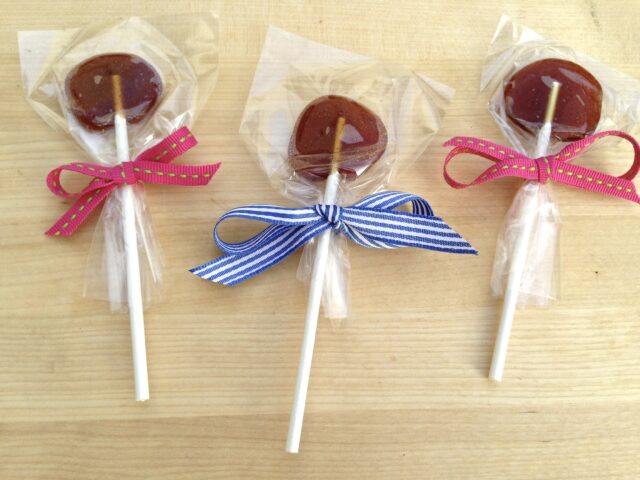Editor’s Note: This recipe has been removed from the owners site. We linked to it from this page and noticed the broken link. We have made a duplicate with all links in tact. This was originally on The Fountain Avenue Kitchen.
In the past few months, I have read several times about the antibacterial, antiviral, and anti-fungal properties of honey and cinnamon. I am certainly not a doctor, but when I saw the idea from my friend, Justine, at Full Belly Sisters for a honey lollipop that was supposed to soothe a sore throat, I figured it was worth a try. If nothing else, it would taste good!
Because of what I read, I added cinnamon to the lollipops. After making them, I let the kids and their friends sample the home remedy—they got good reviews in the taste department–then put the rest away for when the next cold struck. When my older son got the knock-out-drag-down flu recently, we put them to the test. He reported that the honey concoction soothed his sore throat and asked for them several times over the next few days. Whether it was truly an effective natural medicine or a placebo effect, we were both pleased with the results.
For a child who is at least two years old, these would be a good alternative to a cough drop, which may pose a choking hazard. Conversely, you could make these as a cough drop, simply omitting the stick, for an adult or older child. If you end up with more lollipops than you need to sooth a sore throat, they will keep indefinitely stored in a cool, dry place and may also be used as a sweetener/stirrer in a cup of hot tea. I highly recommend making them in advance and having them on hand for the next time a soar throat strikes…and please let me know what you think!
Honey Lollipops — a Natural Sore Throat Remedy
My yield was 13 lollipops, although this may vary somewhat depending on how large you make them. An inexpensive candy thermometer, available in most grocery and kitchen stores, makes these especially easy to prepare.
- 1/3 cup honey
- ¼ teaspoon cinnamon, optional
- Lollipop sticks (available at craft stores)
- Lay the lollipop sticks on a parchment paper-covered baking sheet.
- Pour the honey into a small saucepan and boil over medium-low to medium heat for about 10 minutes or until the temperature on your candy thermometer reads 300 degrees F. The honey will bubble up. Adjust the heat so that the honey continues to bubble but does not boil over, stirring occasionally. (If you do not have a thermometer, you may test the honey for doneness by dropping a drip or two into a bowl of very cold water. If the honey hardens into a ball, it is ready. If it remains soft to the touch, return to a boil.)
- Once the honey has reached 300 degrees F., remove the pan from the burner. Stir the honey and allow it to cool for a minute or two in the pan. Add the cinnamon, if using, and stir to thoroughly incorporate.
- Slowly pour the still-hot mixture over one end of the lollipop sticks. When the honey is very hot, it will spread out and form an uneven circle. Your first few lollipops might be thin and misshapen. As the honey cools, it becomes easier to pour an even circle. If desired, you may even out the first few lollipops by pouring a little more honey over them at the end. The thinner lollipops may be a little sharp around the edges once the honey hardened, so I would recommend making them thicker. Additionally, if your honey cools to the point that it becomes hard to pour, simply return to low heat for a minute or so to thin.
- Once completely cooled, wrap in clear, plastic treat bags and secure with a twist-tie or simply store in an air-tight container, separating the lollipops with a piece of wax or parchment paper.
Notes
Note to parents with kids who have braces: As the lollipops are sucked on, the honey softens and, like taffy, would most likely not be orthodontist approved. If your child likes tea, he or she could instead use the lollipop as a sweet stirrer in the tea.
